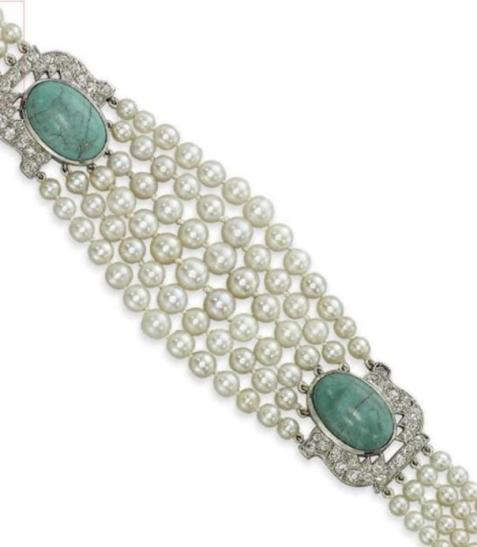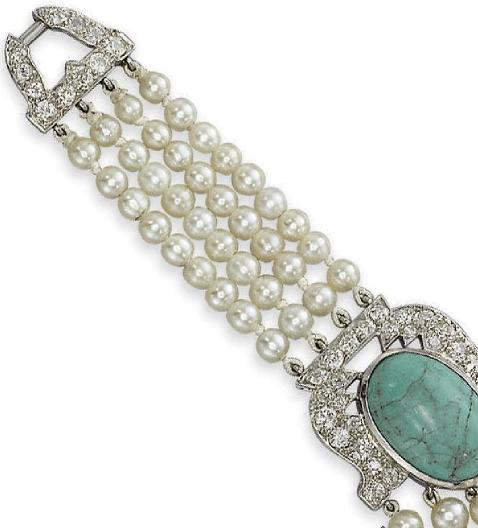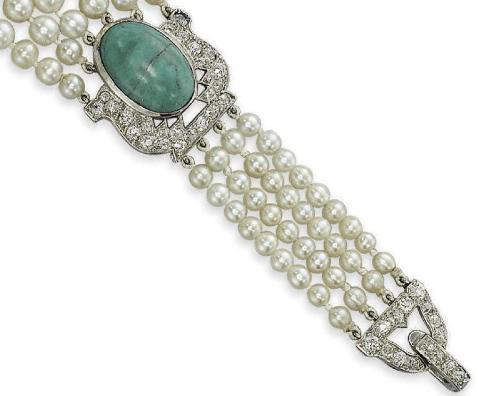Cartier's Art Deco Pearl Diamond and Turquoise Bracelet
Open FREE Unlimited Store Join Our Newsletter
Lareef A. Samad B.Sc. (Hons)
Origin of Name
The name refers to a pearl, diamond and turquoise Art Deco bracelet, designed by Cartier around the year 1925, consisting of six rows of natural pearls in the central section and four rows in the two terminal sections carrying the clasps, that appeared at the Christie's "Jewels : The Geneva Sale" on May 12, 2010, and sold within the pre-sale estimated range of CHF 35,000-45,000 (US$ 31,585-40,610) for a value of CHF43,750 (US$ 39,489).

Cartier's Art Deco Pearl, Diamond & Turquoise Bracelet
© Christie's
Characteristics of the Art Deco Pearl, Diamond and Turquoise Bracelet
Design of the central section of the bracelet
The bracelet having a length of 18.5 cm, is designed in three sections, a wider central or middle section and two narrower terminal sections carrying the clasps.
The wider central section is made up of six rows of graduated pearls, varying in size from 3.1 to 5.5 mm and extending between the turquoise and diamond motifs, probably made of white gold or platinum, at either end. Each turquoise and diamond motif has a bezel-set, central, large, cabochon-cut, oval-shaped, greenish-blue turquoise, partially surrounded on one side by the diamond motif, pave-set with old circular-cut diamonds. Four of the pearl rows in the center arise directly from rings or loops attached to the bezel framework of the turquoise. The two outermost rows of pearls arise from loops attached to the frame of the diamond motif partially surrounding the turquoise. The two outermost rows of pearls are the longest rows of pearls, consisting of 13 pearls in each row. The largest pearl in this row is the 7th pearl, with 6 pearls on either side gradually decreasing in size towards the ends. The next longest rows of pearls are the two rows situated just inner to the outermost rows, and arising from the bezel framework of the turquoise, consisting of 11 pearls each. The largest pearl in this row is the 6th pearl from either end, with 5 pearls on either side gradually decreasing in size towards the ends. The shortest rows of pearls are the two innermost rows of pearls, also arising from the bezel framework of the turquoise, and consisting of 9 pearls each. The largest pearl in these rows is the 5th pearl from either end, with 4 pearls on either side, gradually decreasing in size towards the ends. Thus, in all there are (13 x 2) + (11 x 2) + (9 x2) = 26 + 22 + 18 = 66 pearls, in the central section of the bracelet.

A zoomed image of the central section of the bracelet
© Christie's
The central large pearls in all the 6 rows of pearls, roughly lie along a straight line in the middle of the central section. The pearls in each of the six rows are separated by rondelle spacers. A casual glance of the pearls show that most of the pearls are spherical in shape. However, a more careful examination of the pearls reveal that not all the pearls in the bracelet are spherical. Apart from spherical shape other shapes like near-spherical, button-shaped, and oval-shaped can also be identified. This is a strong evidence for the natural provenance of the pearls. Regular and consistent spherical shapes are common only among cultured pearls. Among natural pearls regular spherical shapes are extremely rare, and one always comes across an assortment of shapes. Putting together a bracelet or necklace made up of natural spherical pearls only is a near impossible task.
Design of the terminal sections of the bracelet
The two narrower terminal sections of the bracelet, situated on either side of the central section are made up of four rows of pearls each. The pearls in these rows appear to be of uniform size, though not necessarily of uniform shape. Here too we can identify pearls having button and oval shapes, situated among spherical and near-spherical pearls. Each of the four rows of pearls consist of 9 pearls. Thus, there are 9 x 4 = 36 pearls in each terminal. The rows of pearls are attached to rings or loops arising from the frame of the diamond motif on one side and from the frame of the clasp on the other side. In these rows rondelle spacers are placed only between the first and second pearls, from either end of the rows. The buckle clasps, also made probably of white gold or platinum, is pave-set with tiny circular-cut diamonds.

Zoomed image of one terminal of the bracelet
© Christie's

Zoomed image of the other terminal of the bracelet
© Christie's
An approximate estimation of the total weight of the pearls based on their range in size
Number of pearls in the central section of the bracelet = 66 pearls
Number of pearls in the two terminal sections = 36 x 2 = 72 pearls
The total number of pearls in the bracelet = 66 + 72 = 138 pearls
The range in size of the pearls = 3.1 mm to 5.5 mm
The average of the range in size = 3.1 + 5.5/2 = 8.6/2 = 4.3 mm.
An approximate average size of the pearls is the median value of the range = 4.3 mm
Using Kunz & Stevenson's conversion table relating size of pearls in mm to weight in grains, given on our webpage, nine-strand natural pearl festoon necklace ,
A size of 4.3 mm is equivalent to 2.25 grains.
Approximate total weight of 138 pearls = 2.25 x 138 grains
= 310.5 grains = 310.5/4 carats
= 77.63 carats =77.63/5 grams
= 15.53 grams
Thus, the approximate estimated weight of the pearls in the brooch = 15 grams.
Characteristics of the pearls in the bracelet
The range in size of the pearls is 3.1 mm to 5.5 mm, equivalent in weight from about 0.75 grain to 4.5 grains from the conversion table. The shape of the pearls are mainly spherical and near-spherical, but there are also button-shaped and oval-shaped pearls among them. The color of the pearls are silvery-white, in which white is the body color of the pearls and silver the overtone color. The luster and orient of the pearls are in keeping with their saltwater origins. The surface quality of the pearls are also excellent and apparently blemish free.
History of the Art Deco Pearl, Diamond and Turquoise bracelet
The probable oyster species in which the pearls originated
The range in size of the pearls and the color and overtone if any of the pearls can give an indication as to the probable species in which the pearls originated. The range in size of the pearls is 3.1 mm to 5.5 mm. This falls within the range in size of pearls produced by the oyster species, Pinctada radiata, the Oriental pearl oyster, that produces pearls of medium size, ranging from around 3 mm to 8 mm, apart from large quantities of seed pearls also produced by them. The silvery-white color of the pearls is also a common color of pearls produced by Pinctada radiata. White and yellow are the common body color of these pearls, and silver, cream and pink are overtone colors. Thus, based on the range in size and the color of the pearls, the most probable oyster species in which they originated is Pinctada radiata, the Oriental pearl oyster.
The probable source of the pearls
Pinctada radiata has gone down in the history of mankind as the most prolific pearl producer, that was responsible for the production of Oriental pearls, that supplied the royal courts of ancient kingdoms and empires since very ancient times. The three main habitats in which the oriental pearls existed in the past, were the pearl banks of the Persian Gulf, the Red Sea and the Gulf of Mannar (between India and Sri Lanka) Ceylon pearls from the Gulf of Mannar were renowned for their white body color with silver overtones. White pearls with yellowish hue were rare among Ceylon pearls. The Persian Gulf pearls originating from Bahrain and other Gulf countries, also had the desirable silvery-white colors, but white pearls with yellowish hue were more common among these pearls. Thus, the pearls in this bracelet may have originated in the Gulf of Mannar or the Persian Gulf.
However, given the period of origin of the bracelet as the Art Deco period, that extended from 1920 to around 1940, the most probable source of the pearls is the Persian Gulf, as the pearl fishery in the Gulf persisted during this period. The pearl fishery in the Gulf of Mannar was finally abandoned in 1906, after consistently low yields produced in successive fisheries.
The period of origin of the bracelet
The bracelet designed by Cartier, is believed to have originated around the year 1925, during the Art Deco period, a period during which bracelets had their heyday, and was worn on both lower and upper arms, a fashion that was complementary to the sleeveless dresses of the period in the 1920s. Bracelets of this period were made of white gold or platinum, and were set with diamonds and other precious stones, such as sapphires, rubies and emeralds. Besides this, pearl and diamond bracelets, consisting of several rows of pearls, was also popular during this period. Another popular bracelet of this period was the line bracelet consisting of a straight line of diamonds placed end to end, in flexible square-shaped links. The diamonds used in line bracelets were usually square-cut diamonds, a cut developed in Paris, known as the French cut. Sometimes round-cut diamonds were set inside the square-shaped links. Such bracelets were frequently accented with natural and synthetic rubies, sapphires and emeralds, a combination that was referred to as the "fruit-salad" look.
Art Deco jewelry had a symmetrical and streamlined look, jewelry styles being geometric and linear, in which straight lines and angles were preferred to curved and fluid lines, such as the cubic and lattice motifs. Other bracelets produced were the plaque bracelets and strap bracelets. Cartier produced the famous the multicolored "fruit-salad" bracelets, with clusters of flowers, leaves and berries, made of carved gemstones. Van Cleef & Arpels produced the famous strap bracelets, incorporating Egyptian revival motifs, in pave-set diamonds and colored stones.
Some Art Deco features in the bracelet
Cartier's Art Deco Pearl, Diamond and Turquoise bracelet show some features that are distinctly associated with the Art Deco period. Some of these feature are :-
1) The symmetrical and streamlined geometric pattern of the bracelet.
2) The use of white gold or platinum, two of the common metals used in jewelry during this period. In fact, the alloy white gold was first introduced as a metal for jewelry setting, only in the 1920s.
3) The use of pearls and diamonds in the bracelet, accented by two large, oval-shaped, cabochon-cut, greenish-blue turquoise.
4) The combination of several rows of pearls that forms the strap or band of the bracelet.
Cartier's Art Deco Pearl, Diamond and Turquoise bracelet fetch a price within the pre-sale estimated range
Cartier's Art Deco Pearl, Diamond and Turquoise bracelet was lot no.63, at the Christie's "Jewels : The Geneva Sale" held on May 12, 2010, at the Geneva - Four Seasons Hotel des Bergues. The lot was accompanied by a report bearing no.01743, dated May 4, 2009, issued by the Horsham GPL Gem & Pearl Laboratory, certifying that the pearls are natural saltwater pearls. A pre-sale estimate of CHF 35,000-45,000 (US$ 31,585-40,610) was placed on the bracelet, and in keeping with these expectations, the lot sold for CHF 43,750, equivalent to US$ 39,489.
You are welcome to discuss this post/related topics with Dr Shihaan and other experts from around the world in our FORUMS (forums.internetstones.com)
Related :-
2) Cultured Pearl Jabot-Pin, Coral and Cultured Pearl Bracelet, Princess Margaret's jewelry collection
External Links :-
1) Christie's "Jewels : The Geneva Sale" 1374, May 12, 2010. Lot No.63 - An Art Deco Turquoise, Pearl and Diamond Bracelet, by Cartier.
References :-
1) Christie's "Jewels : The Geneva Sale" 1374, May 12, 2010. Lot No.63 - An Art Deco Turquoise, Pearl and Diamond Bracelet, by Cartier.
2) 200 Years of Jewelry - Bijoux inspired jewels. www.bijouxjewels.com
3) Art Deco - from the Antique Jewelry University. www.langantiques.com
4) Antique Jewekry - Art Deco Bracelets. www.antiquejewelryonline.com
Powered by Ultra Secure
Amazon (USA) Cloud Network

Founder Internet Stones.COM
Register in our Forums
| Featured In
|
|
|
|
|
|
|
|


















